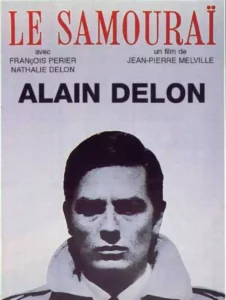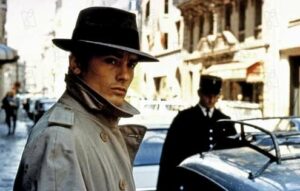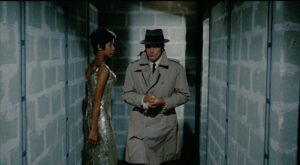“Le Samurai” – a gangster in the style of Alain Delon

Title: “Le Samurai”
Release Date: 1967
Director: Jean-Pierre Melville
Cast: Alain Delon, François Périer, Cathy Rosier, Nathalie Delon and others
“Le Samurai,” directed by Jean-Pierre Melville, established Alain Delon’s unique cinematic image. Jef Costello, the paid assassin played here by the French actor, is not a mindless brute, but a mysterious professional guided by his own code of values. In turn, the sign of his principles is primarily the character’s original style – of dress, movement, the way he speaks and even looks. He could be called a stylish gangster, or even more: an Alain Delon-style gangster.
“Le Samurai” – Melville’s French black crime story
“Le Samurai” is one of the finest films in the oeuvre of the French director, who took his nickname from the name of the American writer Herman Melville. Fascinated by the noir current, the filmmaker created psychologically in-depth pictures referring to this genre and operating with its characteristic iconography. In the main roles, meanwhile, he most often cast two great figures of French cinema: Jean-Paul Belmondo and Alain Delon. In 1967’s “Samurai,” Melville tells the story of Jef Costello, a paid assassin who one rainy April night is about to carry out another assignment. His target is a nightclub owner.
Planned down to the smallest details, the crime is carried out in what are eloquent white gloves. During his escape from the premises, however, Costello meets eye to eye with beautiful pianist Valerie (Cathy Rosier), causing him to end up at the girl’s mercy despite the double alibi he has secured for the night. Indeed, Costello is arrested by the police along with other suspects and put in a confrontation situation. Eventually, for unknown reasons, Valerie denies that he is the perpetrator of the murder. However, this does not solve the gangster’s problems, who is distrusted by both the vigilant police inspector (François Périer) and his principals. The latter decide to liquidate the killer captured by the police. Costello thus falls into a dense web of traps, which turn out to be as intricate as the plan of the Paris metro, where the gripping scene of the hero’s chase takes place.

“Le Samurai” – a stylish French detective story
As befits a film maintained in the neo-noir style, here we have a dark picture of Paris filmed from the nocturnal perspective of labyrinthine streets, nightclubs, closed courtyards and old tenements. The frames of Melville’s film captivate with the beauty of the dark blue-gray color scheme. The smallest details play here, passionately brought out by the luminosity: the shine of a black revolver, the silverness of a bunch of keys, the glow of street lamps, the darkened interior of a nightclub, the metallic color of a car’s body. “Le Samurai” is a film that appeals to the viewer primarily in the visual layer, reducing the role of dialogues and monologues to a minimum. Words are deceptive, in a world of appearances and deception they can only betray weakness or falsity. Instead of them, atmospheric jazz music turns out to be eloquent.
It is she, like Destiny, who lures Costello in the form of a beautiful pianist and leads to inevitable death. Valerie here becomes a femme fatale figure, but she also, through her profession, fits into the almost oneiric atmosphere of the world depicted. The film acquires a metaphorical dimension, functioning on the border between java and dreamy hallucinations to the rhythm of blues and jazz.
“Le Samurai” – a gangster in an elegant hat
However, the most intriguing element of “Le Samurai” remains the creation of the main character. His condition is already outlined by the film’s motto taken from the Japanese Bushido Code: “There is no greater loneliness than that of a samurai, except that of a tiger in the jungle.” Jef Costello here, then, is a ronin who sets his own honorable rules in a criminal jungle without rules. And he does so against the expectations of everyone – both his principals and the law enforcers. Despite the order he receives, he has no intention of shooting Valerie, the only witness to his earlier crime. The revolver he points in her direction is empty and is only meant to draw police deadly bullets.

“Le Samurai” is, of course, a study of human loneliness in the face of life’s decisions, but also a manifesto of faith in the importance of form. For what characterizes Costello is first and foremost his class. We have no access to the character’s thoughts, we can only judge him based on his actions and his appeal. Alain Delon in this role departs from the image of a ruthless or cynical killer. But he also departs from his earlier creations of beautiful lovers, such as in “Eclipse.” A huge emotional charge is located in his determination, his attention to impeccable attire, his powder coat and his inseparable ribbon hat, which he meticulously smooths in front of the mirror. This incredibly masculine, stylish hero with a steely gaze keeps his cut under all circumstances, as he is inwardly poised and true to his principles. This image became Delon’s timeless trademark and set the canon for his later roles, such as “The Red Cirlce” and “A Cop”. Roles in which he created and perpetuated one character – Alain Delon.
Literature:
A.Garbicz, “Cinema. The magic vehicle: journey four. 1966 – 1972”, WL
